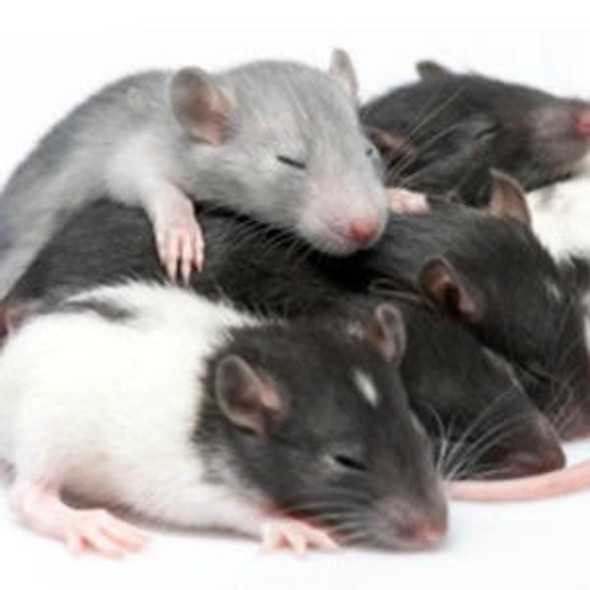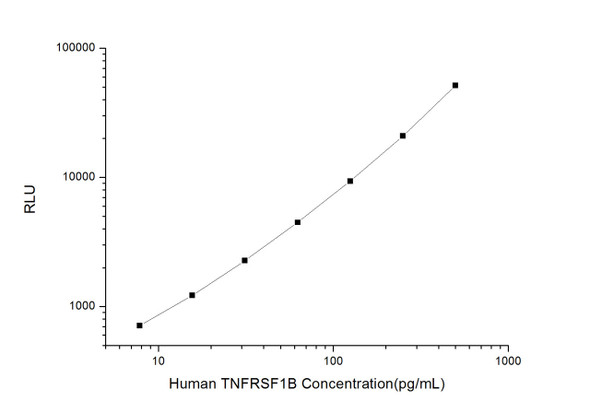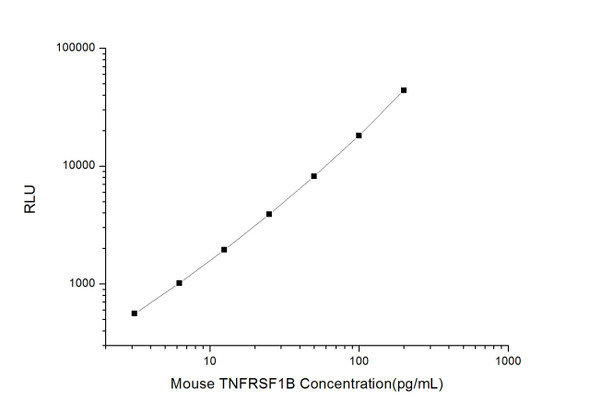Rat Signaling ELISA Kits 3
Rat TNFRSF1B (Tumor Necrosis Factor Receptor Superfamily, Member 1B) CLIA Kit (RTES00578)
- SKU:
- RTES00578
- Product Type:
- ELISA Kit
- ELISA Type:
- CLIA Kit
- Size:
- 96 Assays
- Sensitivity:
- 4.69pg/mL
- Range:
- 7.81-500pg/mL
- ELISA Type:
- Sandwich
- Synonyms:
- TNFR2, CD120b, TBPII, TNF-R-II, TNF-R75, TNFBR, TNFR1B, TNFR80, p75, p75TNFR
- Reactivity:
- Rat
- Sample Type:
- Serum, plasma and other biological fluids
Description
| Assay type: | Sandwich |
| Format: | 96T |
| Assay time: | 4.5h |
| Reactivity: | Rat |
| Detection method: | Chemiluminescence |
| Detection range: | 7.81-500 pg/mL |
| Sensitivity: | 4.69 pg/mL |
| Sample volume: | 100µL |
| Sample type: | Serum, plasma and other biological fluids |
| Repeatability: | CV < 15% |
| Specificity: | This kit recognizes Rat TNFRSF1B in samples. No significant cross-reactivity or interference between Rat TNFRSF1B and analogues was observed. |
This kit uses Sandwich-CLIA as the method. The micro CLIA plate provided in this kit has been pre-coated with an antibody specific to Rat TNFRSF1B. Standards or samples are added to the appropriate micro CLIA plate wells and combined with the specific antibody. Then a biotinylated detection antibody specific for Rat TNFRSF1B and Avidin-Horseradish Peroxidase (HRP) conjugate are added to each micro plate well successively and incubated. Free components are washed away. The substrate solution is added to each well. Only those wells that contain Rat TNFRSF1B, biotinylated detection antibody and Avidin-HRP conjugate will appear fluorescence. The Relative light unit (RLU) value is measured spectrophotometrically by the Chemiluminescence immunoassay analyzer. The RLU value is positively associated with the concentration of Rat TNFRSF1B. The concentration of Rat TNFRSF1B in the samples can be calculated by comparing the RLU of the samples to the standard curve.
| UniProt Protein Function: | TNF-R2: Receptor with high affinity for TNFSF2/TNF-alpha and approximately 5-fold lower affinity for homotrimeric TNFSF1/lymphotoxin-alpha. The TRAF1/TRAF2 complex recruits the apoptotic suppressors BIRC2 and BIRC3 to TNFRSF1B/TNFR2. This receptor mediates most of the metabolic effects of TNF-alpha. Isoform 2 blocks TNF-alpha-induced apoptosis, which suggests that it regulates TNF-alpha function by antagonizing its biological activity. Binds to TRAF2. Interacts with BMX. 2 isoforms of the human protein are produced by alternative splicing. |
| UniProt Protein Details: | Protein type:Membrane protein, integral; Receptor, cytokine Chromosomal Location of Human Ortholog: 1p36. 22 Cellular Component: cell soma; perinuclear region of cytoplasm; extracellular region; integral to membrane; plasma membrane; nucleus; lipid raft Molecular Function:protein binding; tumor necrosis factor receptor activity; ubiquitin protein ligase binding Biological Process: DNA damage response, signal transduction resulting in induction of apoptosis; tumor necrosis factor-mediated signaling pathway; negative regulation of inflammatory response; immune response; RNA destabilization; inflammatory response; positive regulation of membrane protein ectodomain proteolysis; aging |
| NCBI Summary: | The protein encoded by this gene is a member of the TNF-receptor superfamily. This protein and TNF-receptor 1 form a heterocomplex that mediates the recruitment of two anti-apoptotic proteins, c-IAP1 and c-IAP2, which possess E3 ubiquitin ligase activity. The function of IAPs in TNF-receptor signalling is unknown, however, c-IAP1 is thought to potentiate TNF-induced apoptosis by the ubiquitination and degradation of TNF-receptor-associated factor 2, which mediates anti-apoptotic signals. Knockout studies in mice also suggest a role of this protein in protecting neurons from apoptosis by stimulating antioxidative pathways. [provided by RefSeq, Jul 2008] |
| UniProt Code: | Q80WY6 |
| NCBI GenInfo Identifier: | 4507577 |
| NCBI Gene ID: | 7133 |
| NCBI Accession: | NP_001057. 1 |
| UniProt Secondary Accession: | Q80WY6,P25119, Q80WY6, |
| UniProt Related Accession: | P20333 |
| Molecular Weight: | 73kDa |
| NCBI Full Name: | tumor necrosis factor receptor superfamily member 1B |
| NCBI Synonym Full Names: | TNF receptor superfamily member 1B |
| NCBI Official Symbol: | TNFRSF1B |
| NCBI Official Synonym Symbols: | p75; TBPII; TNFBR; TNFR2; CD120b; TNFR1B; TNFR80; TNF-R75; p75TNFR; TNF-R-II |
| NCBI Protein Information: | tumor necrosis factor receptor superfamily member 1B |
| UniProt Protein Name: | Tumor necrosis factor receptor superfamily member 1B |
| UniProt Synonym Protein Names: | Tumor necrosis factor receptor 2; TNF-R2; Tumor necrosis factor receptor type II; TNF-RII; TNFR-II; p75; p80 TNF-alpha receptor; CD_antigen: CD120b; INN: EtanerceptCleaved into the following 2 chains:Tumor necrosis factor receptor superfamily member 1b, membrane form; Tumor necrosis factor-binding protein 2Alternative name(s):TBP-2; TBPII |
| UniProt Gene Name: | TNFRSF1B |
| UniProt Entry Name: | TNR1B_HUMAN |
As the RLU values of the standard curve may vary according to the conditions of the actual assay performance (e. g. operator, pipetting technique, washing technique or temperature effects), the operator should establish a standard curve for each test. Typical standard curve and data is provided below for reference only.
| Concentration (pg/mL) | RLU | Average | Corrected |
| 500 | 47933 55141 | 51537 | 51508 |
| 250 | 19117 22879 | 20998 | 20969 |
| 125 | 9716 9076 | 9396 | 9367 |
| 62.5 | 4273 4751 | 4512 | 4483 |
| 31.25 | 2445 2153 | 2299 | 2270 |
| 15.63 | 1293 1207 | 1250 | 1221 |
| 7.81 | 733 747 | 740 | 711 |
| 0 | 28 30 | 29 | -- |
Precision
Intra-assay Precision (Precision within an assay): 3 samples with low, mid range and high level Rat TNFRSF1B were tested 20 times on one plate, respectively.
Inter-assay Precision (Precision between assays): 3 samples with low, mid range and high level Rat TNFRSF1B were tested on 3 different plates, 20 replicates in each plate.
| Intra-assay Precision | Inter-assay Precision | |||||
| Sample | 1 | 2 | 3 | 1 | 2 | 3 |
| n | 20 | 20 | 20 | 20 | 20 | 20 |
| Mean (pg/mL) | 27.61 | 68.68 | 247.40 | 29.53 | 66.11 | 233.13 |
| Standard deviation | 2.92 | 5.49 | 25.88 | 3.06 | 6.61 | 16.34 |
| C V (%) | 10.58 | 7.99 | 10.46 | 10.36 | 10.00 | 7.01 |
Recovery
The recovery of Rat TNFRSF1B spiked at three different levels in samples throughout the range of the assay was evaluated in various matrices.
| Sample Type | Range (%) | Average Recovery (%) |
| Serum (n=5) | 92-102 | 97 |
| EDTA plasma (n=5) | 93-107 | 98 |
| Cell culture media (n=5) | 98-115 | 106 |
Linearity
Samples were spiked with high concentrations of Rat TNFRSF1B and diluted with Reference Standard & Sample Diluent to produce samples with values within the range of the assay.
| Serum (n=5) | EDTA plasma (n=5) | Cell culture media (n=5) | ||
| 1:2 | Range (%) | 95-106 | 87-99 | 92-105 |
| Average (%) | 100 | 92 | 98 | |
| 1:4 | Range (%) | 87-99 | 88-98 | 100-116 |
| Average (%) | 94 | 93 | 106 | |
| 1:8 | Range (%) | 98-114 | 95-110 | 95-110 |
| Average (%) | 105 | 101 | 103 | |
| 1:16 | Range (%) | 95-110 | 98-110 | 83-99 |
| Average (%) | 101 | 104 | 90 |
An unopened kit can be stored at 4°C for 1 month. If the kit is not used within 1 month, store the items separately according to the following conditions once the kit is received.
| Item | Specifications | Storage |
| Micro CLIA Plate(Dismountable) | 8 wells ×12 strips | -20°C, 6 months |
| Reference Standard | 2 vials | |
| Concentrated Biotinylated Detection Ab (100×) | 1 vial, 120 µL | |
| Concentrated HRP Conjugate (100×) | 1 vial, 120 µL | -20°C(shading light), 6 months |
| Reference Standard & Sample Diluent | 1 vial, 20 mL | 4°C, 6 months |
| Biotinylated Detection Ab Diluent | 1 vial, 14 mL | |
| HRP Conjugate Diluent | 1 vial, 14 mL | |
| Concentrated Wash Buffer (25×) | 1 vial, 30 mL | |
| Substrate Reagent A | 1 vial, 5 mL | 4°C (shading light) |
| Substrate Reagent B | 1 vial, 5 mL | 4°C (shading light) |
| Plate Sealer | 5 pieces | |
| Product Description | 1 copy | |
| Certificate of Analysis | 1 copy |
- Set standard, test sample and control (zero) wells on the pre-coated plate and record theirpositions. It is recommended to measure each standard and sample in duplicate. Note: addall solutions to the bottom of the plate wells while avoiding contact with the well walls. Ensuresolutions do not foam when adding to the wells.
- Aliquot 100µl of standard solutions into the standard wells.
- Add 100µl of Sample / Standard dilution buffer into the control (zero) well.
- Add 100µl of properly diluted sample (serum, plasma, tissue homogenates and otherbiological fluids. ) into test sample wells.
- Cover the plate with the sealer provided in the kit and incubate for 90 min at 37°C.
- Aspirate the liquid from each well, do not wash. Immediately add 100µL of BiotinylatedDetection Ab working solution to each well. Cover the plate with a plate seal and gently mix. Incubate for 1 hour at 37°C.
- Aspirate or decant the solution from the plate and add 350µL of wash buffer to each welland incubate for 1-2 minutes at room temperature. Aspirate the solution from each well andclap the plate on absorbent filter paper to dry. Repeat this process 3 times. Note: a microplatewasher can be used in this step and other wash steps.
- Add 100µL of HRP Conjugate working solution to each well. Cover with a plate seal andincubate for 30 min at 37°C.
- Aspirate or decant the solution from each well. Repeat the wash process for five times asconducted in step 7.
- Add 100µL of Substrate mixture solution to each well. Cover with a new plate seal andincubate for no more than 5 min at 37°C. Protect the plate from light.
- Determine the RLU value of each well immediately.






